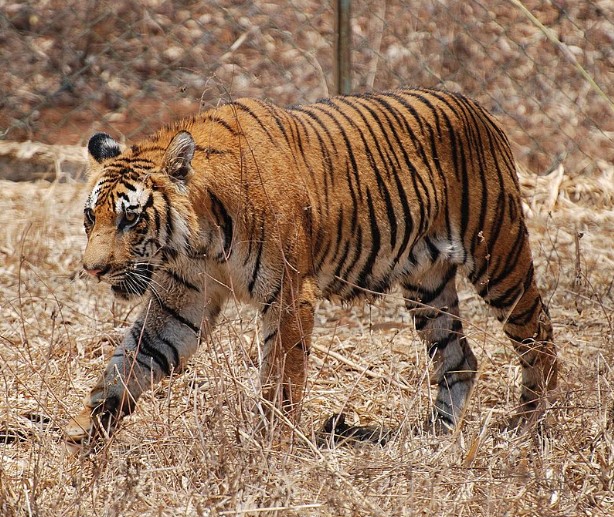
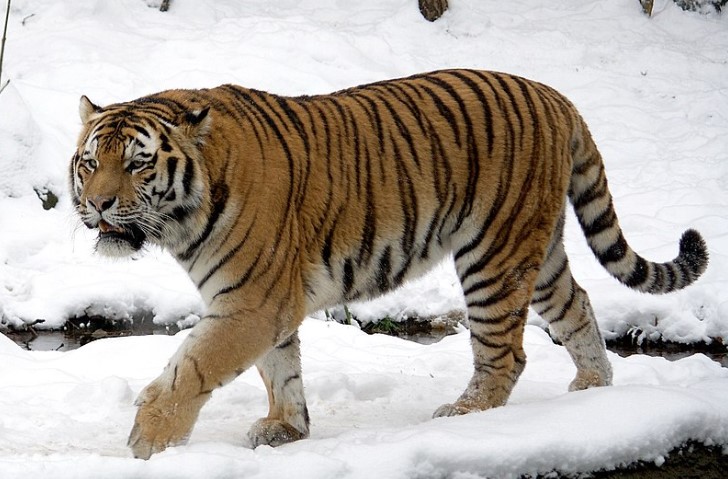
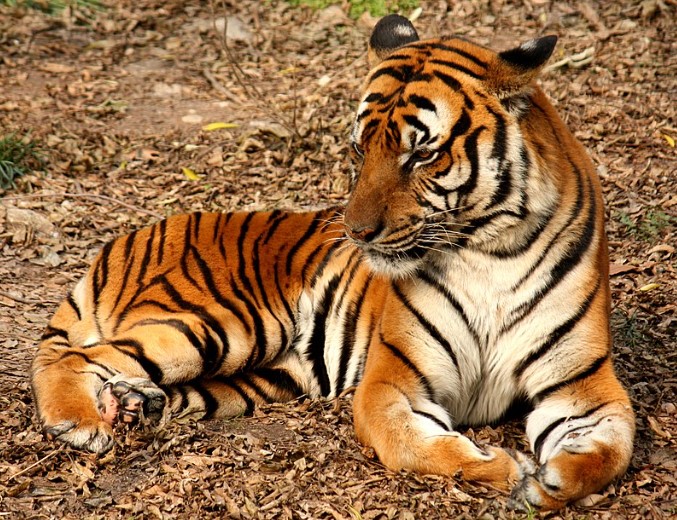
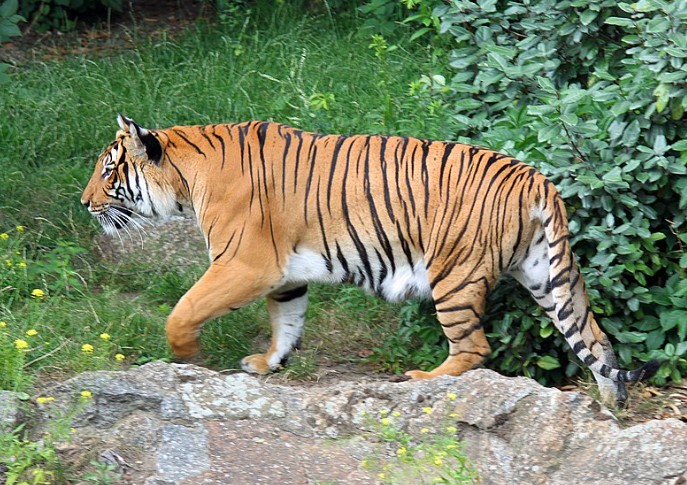

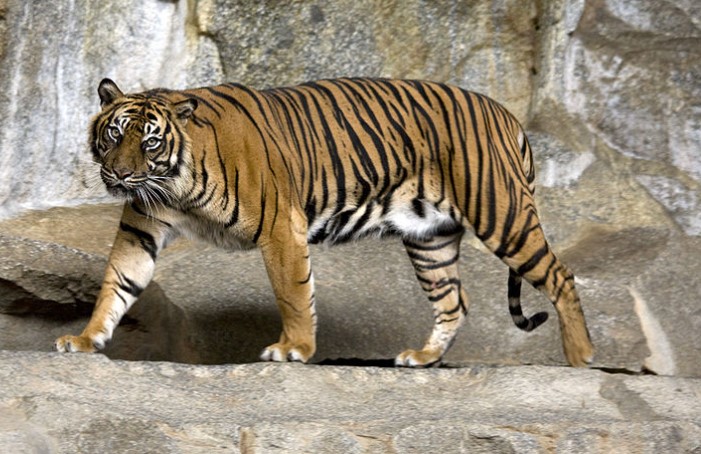
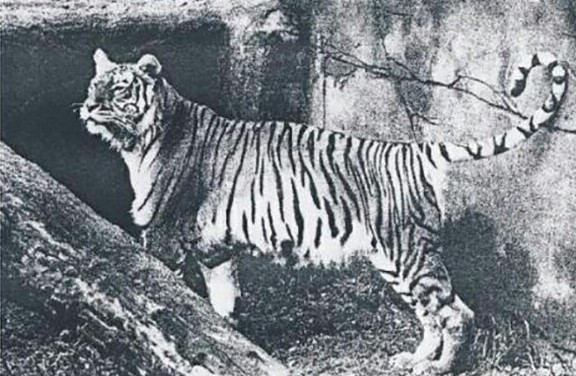

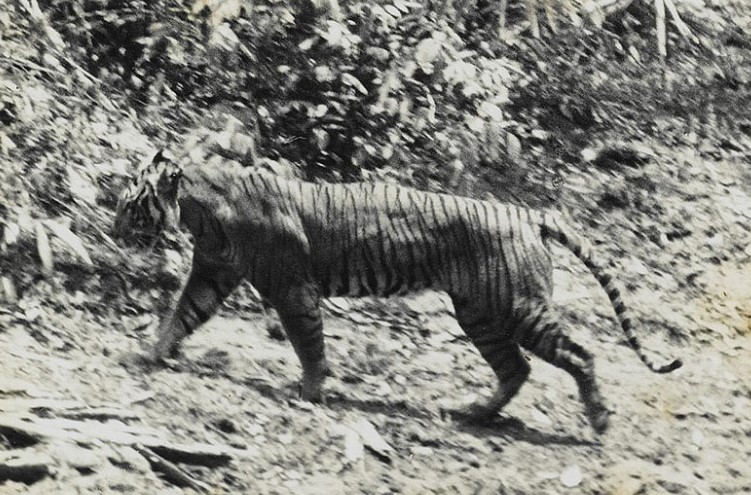









The tiger is the world’s largest cat in the world. They are big cats that are found in Asia. They have developed into 9 subspecies with 6 still alive today. There are 6 subspecies of tigers: the Bengal Tiger, the Siberian Tiger, the South China Tiger, the Indochinese Tiger, the Malayan Tiger, and the Sumatran Tiger. The 3 subspecies: the Bali Tiger, the Caspian Tiger, and the Javan Tiger had gone extinct.
Tigers are muscular cats with strong forelimbs, a large head, and a tail that is about half the length of its body. They have fur, which varies between different shades of orange, and a white underside. They have black stripes that also appear on their skin. There is also a variant called the white tiger. It’s completely white but has brown stripes.
Unlike lions which live in prides, tigers lead solitary lives. They only come together to mate when a mother raises her cubs. They mark their territories with scent and urine. Tigers are not always territorial and relationships can be complex. Unlike male lions, male tigers allow females and cubs to feed on the kill before the male is finished. The gestation period ranges from 93 to 114 days. The cubs are born in March and June. Litters consist of two or three cubs, rarely as many as six. They are born helpless and blind. After 6 to 14 days, their eyes open. When they are weaned from her milk, they follow their mom, who teaches them how to hunt.
Tigers are carnivores or meat-eaters. When hunting, they mostly prey on ungulates. Their selected prey is mostly sambar deer, barasingha, and wild boar. They’re capable of taking down larger prey like gaur and water buffalo. They are very great swimmers and mostly prey on fish. They don't prey on full-grown Asian elephants and Indian rhinoceroses but they do take the vulnerable calves. When close to humans, tigers will also sometimes prey on such domestic livestock as cattle, horses, and donkeys.
These subspecies of tiger are still living today. Some are Endangered but others are Critically Endangered.
The Bengal Tiger(Panthera tigris tigris) is the most well-known species of tiger. It’s mostly found in countries like India, Nepal, Bhutan, and Bangladesh. They are mostly found in tropical forests, swamps, and marshes. It’s considered Endangered on the IUCN Red List.
The Siberian Tiger(Panthera tigris altaica), which is also called the Amur tiger, is the largest cat in the world. It’s found in the Russian Far East, Northern China, and North Korea. It’s mostly found in snowy mountains. It preys on sika deer, Siberian roe deer, and the Siberian musk deer. It’s considered Endangered on the IUCN Red List.
The South China Tiger(Panthera tigris amoyensis) is a subspecies of tiger. It’s native to southern China where it’s mostly found in forests. It’s listed as Critically Endangered on the IUCN Red List.
The Indochinese Tiger(Panthera tigris corbetti) is native to Southeast Asia. It’s mostly found in Myanmar, Thailand, and Laos. Its ground coloration is darker with more rather short and narrow single stripes. It’s listed as Endangered on the IUCN Red List.
The Malayan Tiger(Panthera tigris jacksoni) is a subspecies of tiger. It’s native to Peninsular Malaysia. It inhabits the southern and central parts of the Malay Peninsula. It mostly lives in riparian habitats close to forests. It’s listed as Critically Endangered on the IUCN Red List.
The Sumatran Tiger(Panthera tigris sumatrae) is a subspecies of tiger. It’s the only surviving tiger population in the Sunda Islands, where the Bali and Javan tigers are extinct. Sumatran tigers are found on the island of Sumatra. They’re listed as Critically Endangered on the IUCN Red List.
These subspecies of tiger have gone extinct in the past.
The Bali Tiger(Panthera tigris balica) is an extinct subspecies of tiger. It was the smallest tiger in the Sunda Islands. At the end of the 19th century, palm plantations and rice fields went into the habitat and decreased it. Hunting the tigers started when the Dutch gained control of Bali. In 1941, the game reserve called West Bali National Park was set up to protect the species but the species got extinct, unfortunately.
The Caspian Tiger(Panthera tigris virgata) is an extinct subspecies of tiger. It was native to eastern Turkey, northern Iran, Mesopotamia, around the Caspian Sea in the Caucasus, and northern Afghanistan. The fur color was generally brighter and more uniform than that of the Siberian tiger. The stripes were narrower, fuller, and more closely set. The color of its stripes was a mixture of brown or cinnamon shades. Pure black patterns were invariably found only on the head, neck, the middle of the back, and at the tip of the tail. The extinction was caused by the Russian colonization of Turkestan during the late 19th century. It was caused because of hunting by large parties of sportsmen and military personnel who also hunted tiger prey species such as wild pigs and the reed beds being converted to cropland.
The Javan Tiger(Panthera tigris sondaica) is an extinct subspecies of tiger. It was native to Java and was one of three tiger subspecies on the Sunda Islands. The Javan tiger was small compared to other subspecies of the Asian mainland, but larger than the Bali tiger, and similar in size to the Sumatran tiger. It usually had long and thin stripes, which were slightly more numerous than those of the Sumatran tiger. Its extinction was caused by the bounties for hunting the tiger which were issued in the 1830s. The extirpation was also caused because natural forests were increasingly fragmented after World War II for plantations of teak, coffee, and rubber, and its most important prey, the Javan rusa, was lost to disease in several reserves and forests during the 1960s.
Tigers are going extinct everywhere in Asia. The Bali, Caspian, and Javan tigers have gone extinct due to hunting and habitat loss. Tigers are still disappearing today. As human settlements increase, their habitat is shrinking which makes them go to the settlements where they prey on livestock. Farmers sometimes kill them in retaliation. Tigers are killed for their skins. They’re also killed for their body parts which are sometimes used in Chinese medicine.